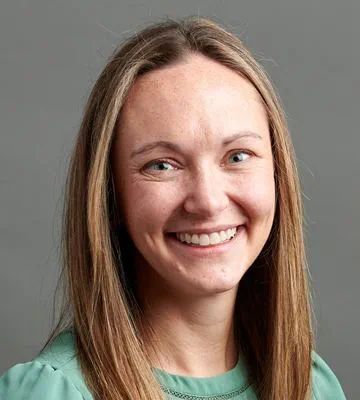Session Details
Improving Injury Prevention Strategies
Grand Salon A/B/C/D
2. To improve safe sleep practices amongst parents and caregivers in different settings

Director, Division of General Pediatrics
Vice Chair, Faculty Affairs
Rush University Medical Center
Chicago, IL
kyran_quinlan@rush.edu
Impact of Standardization on Racial and Socioeconomic Disparities in Non-Accidental Trauma Evaluations in a Pediatric Emergency Department

Emergency Medicine Staff Physician
Laura.Even@cchmc.org
Laura E. Elliott, MD
Michael A. Gittelman, MD
Eileen M. Kurowski, MD MS
Elena M. Duma, MD
Wendy J. Pomerantz, MD
Multiple studies have illustrated racial and socioeconomic disparities in workups of non-accidental trauma (NAT). We aimed to investigate how implementation of a standardized, age-based NAT guideline in a pediatric emergency department (PED) impacted racial and socioeconomic disparities in NAT work-ups.
We conducted a retrospective chart review of patients < 6 months old who presented to our level 1 trauma center PED and satellite community PED. Patients with an injury diagnosis code concerning for NAT, as defined in our guideline, between 1/1/2012 and 12/31/2020 were included. Critically ill patients, those with bone or bleeding problems, those with injuries not in the guidelines or injuries due to motor vehicle crashes, and those with witnessed injuries were excluded. Variables abstracted from the health record included patient demographics and components of the standardized NAT guideline for patients < 6 months of age (skeletal survey, head CT, ALT, AST, lipase). A standardized manual chart review process was utilized to review charts for inclusion/exclusion criteria, to review injuries coded as “unspecified,” and to determine if a social work (SW) consult was obtained and if child protective services (CPS) was notified. Full NAT work-up was defined as head CT, skeletal survey, AST/ALT, lipase, and SW consult. Patients’ home addresses were geocoded to a specific census tract, and a social deprivation index (SDI) was assigned. A steady state of guideline adherence was reached in January 2016, and comparisons were made between the periods before and after with Chi-Square and student’s t-tests.
A total of 870 patients (432 pre- and 438 post-guideline) were included for analysis. Before guideline implementation, more patients with governmental than commercial insurance had SW consults (56% vs 34.6%, p< 0.001) and skeletal surveys (53.8% vs 40.5%, p=0.02); these differences were not seen after the guideline. More patients with governmental insurance had CPS reports filed both before (34.1% vs 13.7%, p< 0.001) and after (39% vs 16.4%, p< 0.001) the guideline. Overall adherence to all guideline elements increased from 19.2% before guideline implementation to 54.8% after implementation (p< 0.001). The portion of patients who underwent complete workups and had CPS reports filed increased after guideline implementation (13.7% vs 28.5%, p< 0.001). Fractures accounted for the greatest number of injury codes both pre- and post-guideline; complete workup of fractures increased from 30.4% pre-guideline to 73.7% post-guideline (p< 0.001). There were no differences in race, ethnicity, insurance type, or SDI among who had full NAT work-ups before or after the guideline was implemented.
Implementation of a standardized NAT guideline led to significant increase in complete NAT workups. Increase in CPS reporting after guideline implementation suggests that increased testing may have led to increased injury identification and prevention of further injuries. Guideline implementation did not introduce new racial or socioeconomic disparities in NAT workups.
1) Compare non-accidental trauma (NAT) workup compliance before and after implementation of an age-based guideline implementation.
2) Describe the disparities that exist in NAT workup between patients with governmental and commercial insurance.
3) Discuss how implementation of an age-based NAT guideline impacted disparities in workup between patients with governmental and commercial insurance.
Safe at Home: Prevention of Pediatric Unintentional Injuries

University of Alabama at Birmingham
Heersink School of Medicine
crburch@uab.edu
Coleman Burch, BS
Alicia Webb, MD
Eric Jorge, MD
Michele Nichols, MD
Kathy Monroe, MD
Unintentional injuries are the leading cause of death in children in the United States. Studies have shown that parental adherence to safety guidelines is improved over education alone when education is provided in conjunction with safety equipment. A prior study at this institution suggested the pediatric emergency department (PED) is an appropriate site for education and safety equipment distribution and showed that families were using devices at follow up. This study built on the prior study and primarily sought to determine if families had previously been educated by a healthcare professional about medication or firearm storage.
A survey about medication and firearm storage was administered to a convenience sample of caregivers presenting to a PED within a freestanding pediatric tertiary care center. The project partnered with the hospital foundation and the School of Medicine. English-speaking caregivers of patients with an Emergency Severity Index (ESI) score of 3, 4, and 5 were approached. Participants verbally completed a survey conducted by a medical student that was approximately five minutes in length. The student provided each family with a medication lock box (if children 5 years old or younger lived in the home), a firearm cable lock, and provided education for safe storage of medications and firearms in the home.
The medical student researcher spent a total of 20 hours in the PED from June to August 2021. 106 families were approached to participate in the study, of which 99 agreed to participate (93.4%). A total of 199 children were reached with ages ranging from less than 1 year old to 18 years old. A total of 73 medication lockboxes and 95 firearm locks were distributed. The majority (79.8%) of survey participants were the mother of the patient and 97.0% of participants lived with the patient more than 50% of the time. For medication storage, 12.1% of families stored medications locked and 71.7% reported never receiving medication storage education from a healthcare professional. Regarding firearms, 65.2% of participants who reported having at least one firearm in the home reported storing firearms safely (locked and unloaded). 77.8% of firearm owners reported storing ammunition in a separate location from the firearm. Of all participants surveyed, 82.8% reported never receiving firearm storage education from a healthcare professional.
The PED is an excellent setting for injury prevention education. Many families are not storing medications and firearms safely nor do they recall having ever received education from a healthcare professional. This demonstrates a clear opportunity to increase knowledge and safety behaviors for caregivers of children.
1) Understand whether caregivers remember having previously received anticipatory guidance on injury prevention methods from healthcare workers.
2) Discuss the importance of providing safety equipment alongside injury prevention education to increase adherence to safe behaviors.
3) Understand how the ED is an efficient and effective setting for injury prevention in pediatric populations.
Development and Use of a Childrens Injury database

Pediatric Emergency Medicine
University of Alabama at Birmingham
jennifermccain@uabmc.edu
Ashley Bridgmon, MPH, MBA
Jennifer E. McCain, MD
Kathy Monroe, MSQI, MD
William King, RPh, MPH, DrPH
The Children’s Injury Database (CID) was developed from emergency department (ED) visit data at our pediatric hospital. CID has 3 objectives: 1) to collect, analyze, interpret and report epidemiologic and clinical data; 2) to translate these data to community preventive action; 3) to stimulate new research and educational projects in injury prevention.
Epidemiologic, financial, clinical and outcomes variables are provided by our hospital Information Systems in Excel and data analysis is performed using Epi Info Version 7 (CDC). Report formats are developed by the core research team and includes Al Safe Kids and IFCK program leadership. CID and research projects utilizing CID data are IRB reviewed and approved.
During 2021, a total of 15,142 injury visits were analyzed representing 22% of total ED visits (68,834). A total of 2,049 injury visits (13.5%) resulted in hospital admission. Males accounted for 56.8% and racial representation included white (56.7%) black (41.1%) and other (2.2%). The median age of injury patients was 6 years. Median ESI was 4.0. T1 and T2 were documented for 2.7% of injury visits. Seasonal distribution was near uniform, although spring had the highest proportion of injury visits at 27.6%. The 10 leading injury types included (in rank order): falls, poison, mvc, atv, assault, dog bites, sports, burns, pedestrian, bicycle. The injuries with highest admission rates (%) were drowning (40.0%), motorcycle (34.4%), foreign body (35.8%), self-harm (34.8%), poisoning (32.6%), ATV (29.0%). Injury ED visits (admissions and discharges) accounted for $197,476,732 in total charges and among those admitted, 10,407 days of stay. Admission rates varied by age group with ages 13 years and older having the highest rate of admission of 18.5%. Over two years, data from CID has been used in over 23 reports supporting education planning and policy development by our hospital. Additionally, during 2021, CID contributed data to 5 research projects submitted to regional and national meetings.
ED injury surveillance (EDIS) can be a valuable tool for understanding the epidemiology of serious, nonfatal forms of child injury. CID has highlighted local area and state priority injuries for community based injury prevention programs and can support statewide policy efforts. Hospital web based messaging, blogs, podcasts and other forms can be data driven and location specific. Importantly, EDIS can be a stimulus for new research ideas, intervention planning and evaluation.
1. review the importance of local surveillance of injuries
2. demonstrate the usefulness of maintaining a local injury database
3. illustrate uses of a database (outreach planning, priorizing projects, research, etc)
Pre- and Postnatal Safe Sleep Knowledge and Planned as Compared to Actual Infant Sleep Practices
University of Iowa Stead Family Children’s Hospital
Paula Valino Ramos, BS
Pam Hoogerwerf, BS
Penny Smith, BSN, RNC-NIC
Carolyn Finley, MSN, RN, CNL
Morgan Swanson, BS
Uche Okoro, MBBS, DrPH
Charles Jennissen, MD
Our study objectives were to examine the safe sleep knowledge, attitudes and planned infant sleep practices of expectant mothers and how they were similar or different after their infant’s birth, and whether differences (if present) were associated with any demographic variables.
Study participants were surveyed at their 28-week prenatal and postnatal visits at the obstetric clinics of an academic tertiary medical facility from November 2019-February 2021. Those <18 years and non-English speakers/readers were excluded. After the study commenced, most mothers were not returning for in-person postnatal visits due to the COVID-19 pandemic. Thus, participants were contacted through text messaging encouraging them to take the follow-up survey on-line. Frequency and statistical analyses were performed using Microsoft SAS software, V.9.4.
355 women (44%) completed both the pre- and postnatal survey. Survey comparisons demonstrated that many participants increased their safe sleep knowledge. For example, of those who were unsure or thought it safe for a baby to sleep in a baby swing/bouncy seat in the house, about two-thirds (67/102, 66%) stated it was unsafe on the postnatal survey. In addition, many who planned sleep practices considered unsafe or were not sure prenatally reported utilizing safe sleep practices on their postnatal survey. For example, of those unsure or planned to place their infant not on their back (8% of total), nearly two-thirds (64%) reported putting their child to sleep on their back postnatally. Of those not sure or planned to use a crib bumper on the prenatal survey (17% of the total), only 12% were using one at their postnatal visit. Despite this, some reported they would be following safe sleep practices on their prenatal survey but then were not doing so postnatally. For example, of those stating they planned to have their infant sleep in the same room (88% of the total), 16% were actually sleeping in a different room from their baby. Similarly, 13% of those stating they would place their child on their back reported using some other position for sleep on postnatal survey. Certain demographics had higher proportions reporting this reversal for specific safe sleep practices. For example, Caucasians (19%) as compared to other races/ethnicities (5%) and those with incomes ?$75,000 (21%) as compared with those with less income (9%) had higher proportions stating their infant would sleep in the same room but then reported postnatally they were sleeping in a different room, P=0.0094 and P=0.0138, respectively.
Despite increases in safe sleep knowledge and many study participants following safer sleep practices than they had planned at their 28-week prenatal visit, there were also mothers who had planned on safe sleep practices who were not doing so after their baby’s birth. All expectant mothers should receive safe sleep education, but our study identified demographics for which targeted efforts and more effective interventions may be needed.
1. Participants will be able to name three safe sleep topic areas of which the knowledge of pregnant women increased the most from their 28-week prenatal visit to that postpartum.
2. They will be able to state three safe sleep practices that were followed by a much higher proportion postnatally than what respondents planned on their prenatal survey.
3. Attendees will be able to identify three demographic groups at increased risk for stating they planned on a specific safe sleep practice at their 28-week prenatal visit but then were not following that practice postpartum.
CPASS - Innovations in Promoting Safe Infant Sleep among High Risk Urban Communities

Felicia Clark, D-ABMDI
Christie Lawrence, DNP, APRN
Darren Harris,
Kyran Quinlan, MD, MPH
Gina Lowell MD, MPH
Innovation in efforts to prevent Sudden Unexpected Infant Death (SUID) is desperately needed since little progress has been made with current efforts over the past 2 decades. In 2021, the American Academy of Pediatrics (AAP), in partnership with IFCK and Amazon, announced a unique funding opportunity for children’s hospitals to partner with family-serving community agencies to promote safe sleep education and distribute safe sleep kits during the prenatal period to communities most impacted by SUID: Community Partnership Approaches to Safe Sleep (CPASS). Our city experiences the largest racial and ethnic disparity in SUID among the largest US cities. Our Hospital/Community Agency Partnership applied for and received CPASS funding for 2022.
Our CPASS site is a partnership of our Injury Free PI, Faculty Champions, Community Educator, and Community Partner Lead. The Community Educator is the former Child Death Scene Investigator for our County Medical Examiner’s Office who conducted hundreds of infant death investigations over the prior decade. The PI, Faculty Champion and Community Educator collaborate to lead the CDC’s SUID Case Registry for the County. SUID mapping targeted prevention efforts. The Faculty Champions are the co-leads of our Hospital Safe Sleep workgroup and are experienced in both hospital-based and community-facing efforts to promote safe sleep. The Community Partner is Center Director and networked with other Centers throughout our city's most impacted communities. The team created a professionally produced 3-minute video that respectfully navigates specific aspects of SUID in at-risk black infants here.
Our CPASS Partnership will distribute 200 safe sleep kits (which include cribettes) to our most impacted neighborhoods through community outreach events. The Community Educator and Community Partner Lead collaborated first at an event involving both outreach and networking opportunities, generating links to 7 other community support agencies providing diverse services for families. The Community Educator also leveraged her knowledge of community support agencies, connected with the 50+ “first wives” of pastors of churches and megachurches in high-risk areas, hair and nail salons, and a local news reporter with a massive social media following. Many outreach activities networked the Community Educator to further opportunities. Outreach activities reach as few as 15 individuals to over 1,000 individuals, depending on the forum. To adequately share information about our work, we developed an informational flyer and a google form, containing a unique scan code to our safe sleep video, for families to sign up for safe sleep kits and families to comment on the video content.
This Community Partnership model and our Community Educator’s unique background and approach allow families to share their understanding and experience with the threat of SUID. Our video has helped to connect with high risk families and promote a deeper understanding and knowledge sharing that may elevate family capacity to practice and advance safe sleep in their homes and communities.
1. Community partnerships with parent support agencies enable access to community experience, trusted avenues for outreach and education, and facilitate networking.
2. Allowing space for community members to reflect, tell their stories, and guide safe sleep conversations generates deeper understanding of environmental and/or knowledge barriers that drive unsafe sleep practice.
3. Understanding local SUID data can serve to guide outreach approaches in communities most affected.
